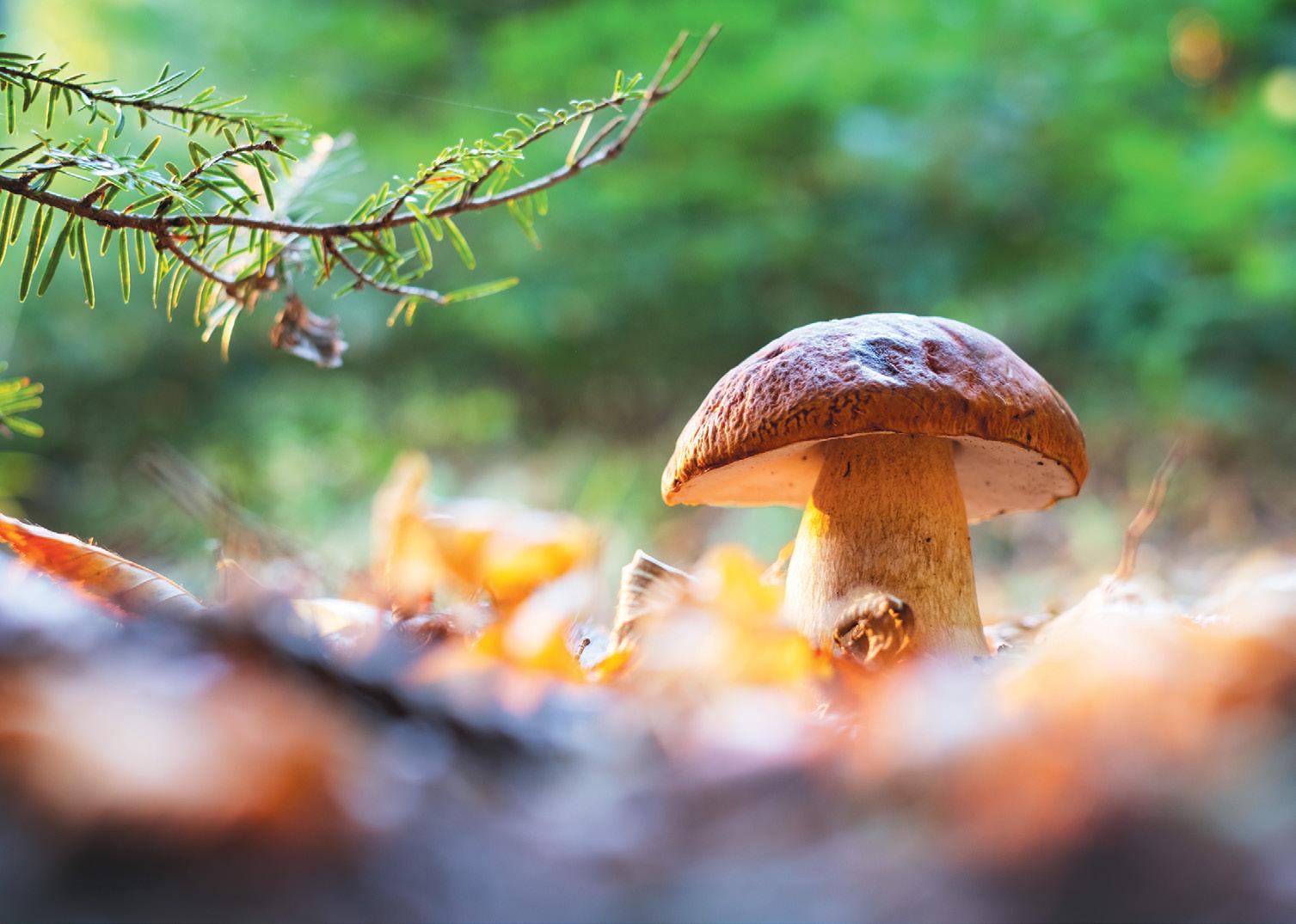
8 minute read
conscious eating
FORAGED FUNGI FARE
Cooking with Wild Mushrooms
Advertisement
by April Thompson
Wild mushrooms can infuse exciting new flavors and textures into familiar dishes, along with a taste of the local terroir, the natural habitat, from woods to plate.
“I first encountered wild mushrooms through local foragers, then later from specialty food purveyors who would fly mushrooms from around the world into our kitchen. They were the most unique ingredients I could find, offering colors, flavors and textures I had never experienced … pure catnip for a chef,” says Alan Bergo, a Minnesota chef and author of The Forager Chef’s Book of Flora. Recipes at ForagerChef.com feature more than 60 species of wild edible fungi, from common deer mushrooms to prized porcinis.
The intriguing flavors of wild mushrooms in part come from their diets, akin to the difference between grain- and grass-fed meats. “For fungi, their food is their habitat. Cultivated mushrooms have less variety of the micronutrients and secondary metabolites that can add flavor to a wild mushroom,” says Eugenia Bone, a New York City food journalist and editor of Fantastic Fungi: The Community Cookbook.
Foraged fungi also offer a host of nutritional benefits surpassing commercially grown mushrooms. Wild mushrooms like chanterelles and morels can contain up to 1,200 international units (IU) of vitamin D
per serving, whereas commercial mushrooms, typically grown in dark conditions, contain less than 40 IU, according to the Harvard School of Public Health.
While foraging is the most satisfying way to procure wild mushrooms, they are becoming increasingly available through farmers’ markets, online purveyors and gourmet stores. Some species that grow wild throughout North America such as oysters, maitake (hen of the woods) and lion’s mane are also grown commercially; these can be suitable for transitioning from buying to hunting.
Sam Fitz, owner of ANXO Cidery & Tasting Room, a neighborhood taproom in Washington, D.C., picked up mushrooming when COVID-19 hit, in part mentored by the restaurant’s wild food purveyor. Fitz started ANXO making hyperlocal ciders from crabapples foraged on bike rides through the nation’s capital, salvaging fruit that otherwise would go to waste. Today, the seasonally focused menu often features wild fungi and other foraged ingredients from savory tartelettes made with beech and hedgehog mushrooms to cocktails made from bitter boletes.
One of ANXO’s signature dishes is a vegan “chicken of the woods” sandwich, served hot, Nashville-style. This orangecolored tree mushroom, also known as sulphur shelf, has a taste, texture and color that so closely resembles chicken that many recipes use it as a meat substitute. “People are so blown away by its meaty texture they can’t believe they are being served mushrooms,” says Fitz.
When preparing mushrooms, “Forget what you know about cooking vegetables,” says Bone. “Also forget the notion that mushrooms are too delicate to take washing or high heat. Mushrooms are extremely hardy because of the chitin in their cell walls, a compound that is more like fingernails than the cellulose of plants. You can cook mushrooms twice and they will still retain their integrity.”
Because the amino acids in mushrooms respond to heat more like meat than vegetables, Bone suggests searing mushrooms on the grill or under the broiler. “A slice of maitake will cook beautifully on the grill,” she says.
When cooking a particular species for the first time, Bone recommends ovenroasting the mushrooms wrapped in parchment paper. “When you open up the parchment, you can really smell the mushroom. It’s a wonderful way to pick up subtle flavor differences and see how the mushroom handles,” she says.
Since fungi take on all sorts of shapes and sizes, Bergo suggests letting a mushroom’s morphology inform how to cook it. Lion’s mane, for example, has a texture that mimics crabmeat, so faux crab cakes make a fun dish that honors its form.
“Chefs tend to chop things up, but I prefer to cook many mushrooms whole, especially when they have interesting shapes,” says Bergo. One of the chef’s go-to preparations of oyster mushrooms is to toss large pieces in seasoned flour or brush them with mustard, then bake until crispy. “They turn into cool-looking, crispy croutons you can put on a salad or eat as a snack,” he says.
Connect with Washington, D.C., freelance writer April Thompson at AprilWrites.com.
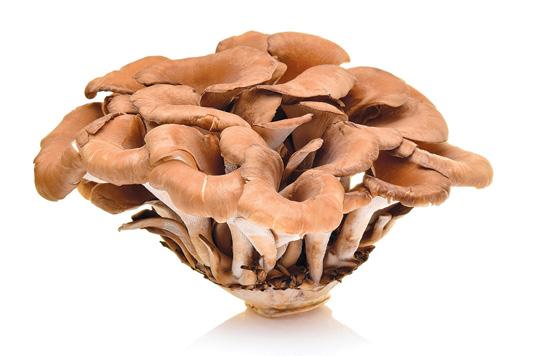
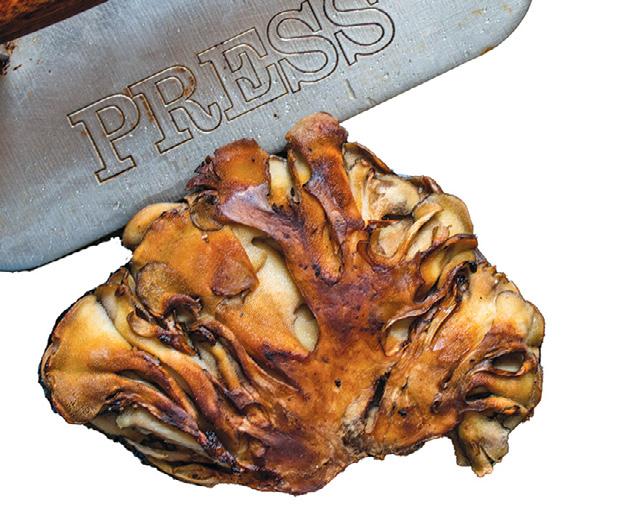
Wild mushrooms are a culinary delight, but beginning foragers should harvest with caution. The forager’s rule of thumb is to be 100 percent sure of an identification 100 percent of the time given that toxic lookalikes can exist. It’s also important to try a small amount of a mushroom the first time around, as some individuals can respond adversely to a particular species despite its general edibility.
Hen of the Woods Steaks
yield: 1 serving per 4 ounces mushrooms
4-oz pieces of hen of the woods (Grifola frondosa) mushrooms, broken into large clusters Kosher salt Cooking oil as needed, about ¼ cup Clean the hens by swishing them in cool water, gently peering inside the caps to make sure they are cleaned, trimming with a paring knife as needed, then allowing to drain on paper towels. Heat the oil in a pan or on a griddle until hot, but not smoking. Add the mushroom clump and season with salt, placing a weight— like a rock, log, crumbly wood or cinder block wrapped in foil or a pan—on top, then cook until the underside is deeply caramelized, then flip and repeat. If the pan gets dry, add a little more oil. When both sides of the mushrooms are deeply caramelized and browned, serve immediately, with extra finishing salt on the side. Recipe from Alan Bergo, ForagerChef.com. akepong/AdobeStock.com
Here is a traditional Italian preparation for chicken of the woods (Laetiporus sulphureus or Laetiporus cincinnatus), flavored with wild monarda leaves and served with charred bread rubbed with garlic.
yield: 4 to 6 servings
1 lb young tender chicken of the woods, sliced ¼- to ½-inch thick 1 large clove garlic ¼ cup mild or extra-virgin olive oil mixed with flavorless oil, like grapeseed (plus 1 or 2 Tbsp extra if the pan threatens to dry out), along with a drizzle at the end 1 large shallot or small yellow onion 1 Tbsp sliced Monarda fistulosa (also known as bee balm or wild bergamot) or fresh mint or oregano Crushed red pepper flakes or hot chili to taste 1 Tbsp capers or a small handful of Castelvetrano olives (or other green olives) 2 dried bay leaves ¼ cup dry white wine ¼ cup water or stock 1½ cups seedless tomato puree or tomato sauce Grilled high-quality bread, preferably slightly charred, for serving 2 whole fresh garlic cloves as needed for rubbing into the bread

Heat the oil in a wide pan with high sides. A cast iron skillet will work, but isn’t ideal as the sauce is acidic.
Add the mushrooms and cook until they’ve given up their moisture, then push them to the side of the pan, add a little extra oil if the pan looks dry, or if the mushrooms were very juicy. Add the garlic to the clean spot of the pan, then arrange the pan off-center on the burner so that the heat is focused on the garlic. Sweat the garlic in the oil slowly until it’s light golden and aromatic, then add the shallots and cook for 1 minute. Add the crushed red pepper directly to the garlic and shallot, cook for a moment more, then deglaze the pan with the wine, tossing in the bay leaf. Reduce the sauce by one half, then add the tomato puree, water, capers or olives, bergamot or other herbs and cook until the mixture is thickened lightly and the mushrooms are coated with a rich sauce, about 15 minutes.
Meanwhile, lightly oil the bread and char on a grill. It should have good black spots, but not be ashy. Rub a garlic clove gently into the toasted bread slices, pressing down so that it “melts” into the bread a bit—don’t go crazy, a little goes a long way. Double check the seasoning of the mushrooms for salt and chili, adjust as needed, then serve the stewed mushrooms with the grilled garlic bread on the side. Drizzle some oil over the top to give the dish an attractive sheen.
Spoon the mushrooms and their sauce on the bread and eat. Leftovers make killer mushroom hoagies a la cheesy meatball sub sandwiches.
Recipe from Alan Bergo, ForagerChef.com.

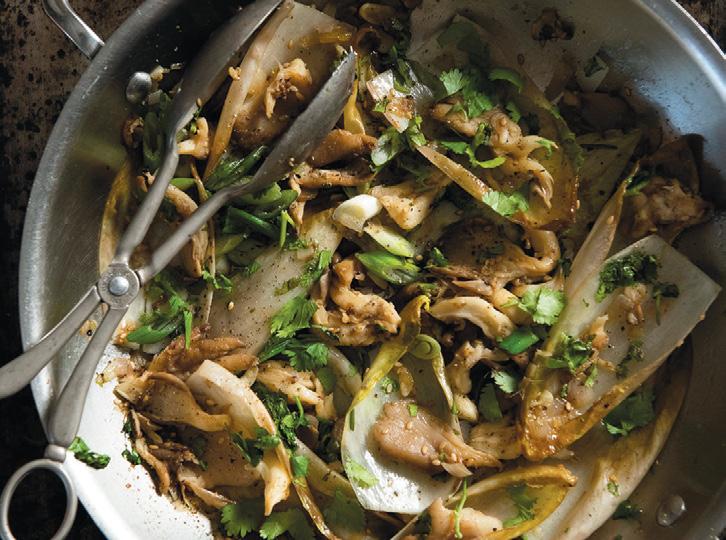
2 Tbsp olive oil ½ cup minced shallots 1 tsp sliced garlic 1 to 2 tsp grated ginger Freshly ground black pepper 6 oz oyster mushrooms 1 Tbsp white or black sesame seeds 2 marinated white anchovy fillets, chopped 2 Belgian endives, leaves separated and cut into 2-inch sections ½ Meyer or regular lemon Pinch of kosher salt ⅓ cup chopped fresh cilantro or flat-leafed parsley for garnish 2 whole scallions, chopped diagonally for garnish Drizzle of high-quality white truffle oil for garnish (optional) Grated Parmigiano cheese for garnish (optional) In a wide skillet, heat the olive oil over medium high heat. Add the shallots and garlic, and sauté until golden, a few minutes. Stir in the ginger and pepper to taste. Tear the oyster mushrooms into bite-sized pieces and add. Cook for about 5 minutes, flipping the mushrooms over, until they release their liquid. Add the sesame seeds and toast them in a bald spot in the pan for a minute or so. Turn the heat down to medium, add the anchovies and endives, and cook until the endives wilt, a few more minutes. Take off the heat, add the lemon juice and season with salt. Garnish with the cilantro and scallions, and optionally, white truffle oil and a sprinkle of the cheese.
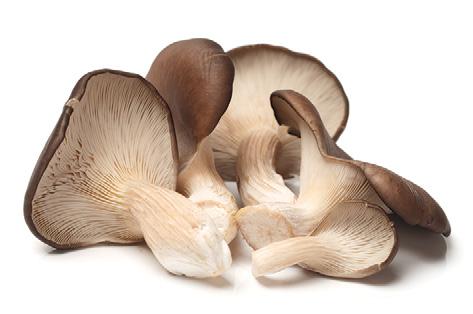
photo by Evan Sung
zcy/AdobeStock.com
Recipe by Annaliese Bischoff from Fantastic Fungi: The Community Cookbook, edited by Eugenia Bone.
Natural Awakenings recommends using organic, non-GMO (genetically modified) and nonbromated ingredients whenever possible.






